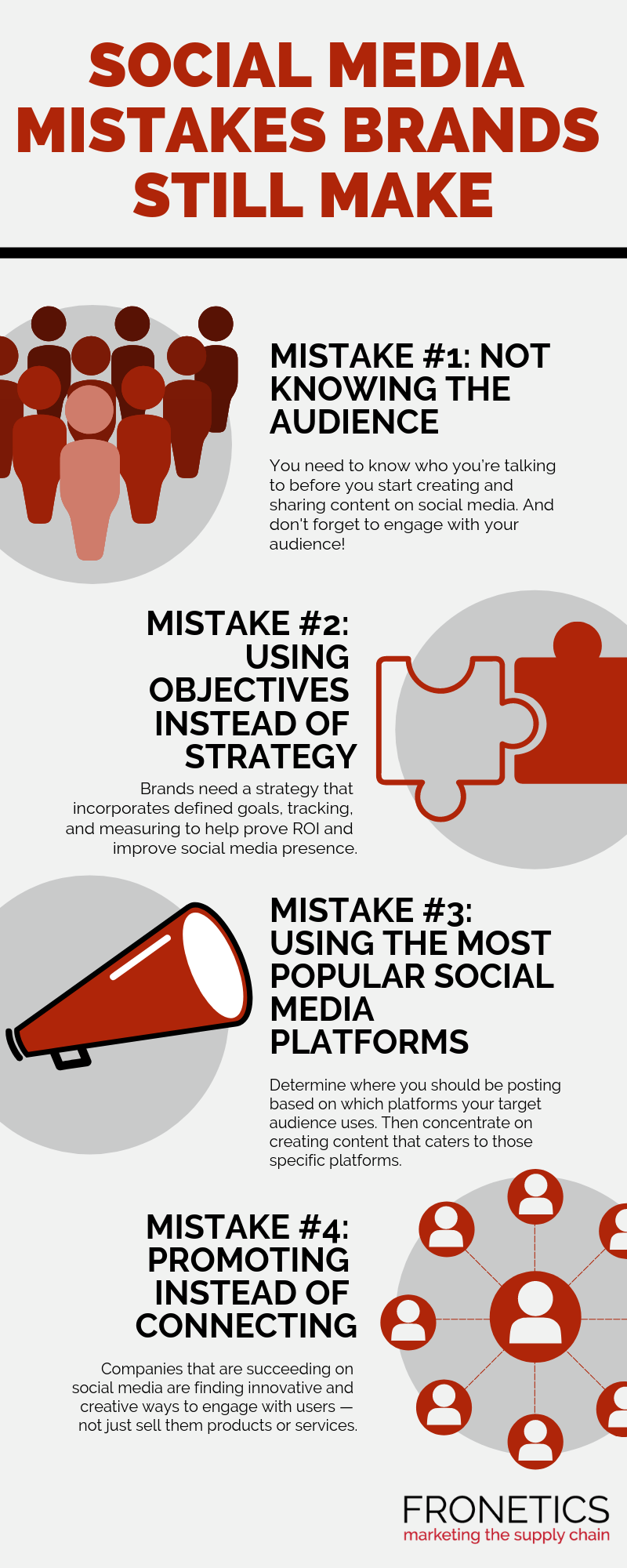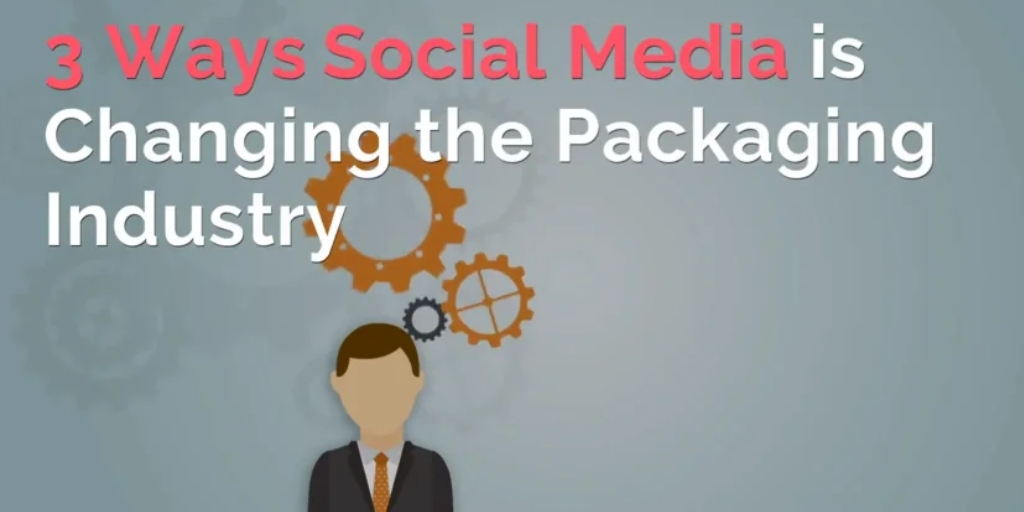
by Fronetics | Mar 8, 2019 | Blog, Marketing, Social Media
Take note: Brands in the supply chain are not immune to these social media mistakes.
Highlights:
- There will be over 3 billion social media users by 2021.
- Not knowing your audience can cripple your efforts.
- Social media is about connecting – not promoting.
Approximately 81% of small and medium businesses use a social platform. And we all understand why. By 2021, it is estimated that there will be around 3.02 billion social media users around the globe. That’s a lot of potential customers.
It’s easy to see why companies are jumping on the social media bandwagon. And there’s no disputing that social mediais an effective way to increase brand awareness and generate leads. But it can be virtually useless if your company isn’t doing it right.
Are you making any social media mistakes? Check out our list of the biggest blunders we see companies making to find out.
4 social media mistakes supply chain brands are still making

(Made with Canva)
Mistake #1: Not knowing the audience
You’d be surprised how often we find that brands don’t have a clear idea of their audience on social media. This covers everything from knowing when followers are active to what content hits home with them to other interests followers might have. You need to know who you’re talking to before you start creating and sharing content on social media.
So how do you figure out your audience? First, it’s important to create a detailed description of your target buyer persona – including location, education level, role in the industry, needs and concerns, and anything else that’s relevant. Next — and we can’t say it enough — engage with your audience! Participate in discussions, encourage comments, and pay attention to what your followers are telling you.
Mistake #2: Using objectives instead of strategy
Social media platforms are continually making changes and updates to improve the user experience. In order to weather these changes and keep your audience engaged, it’s imperative to have a clear strategy that includes types of content, frequency, and pillar topics. Posts should reflect your brand, so make sure posts follow style guidelines and reflect your specific tone.
A strategy will also help achieve ROI. Social Media Examiner’s 2018 Social Media Marketing Industry Report found that only 44% of marketers agree that they know how to measure social media ROI. That means two-thirds of marketers don’t know whether or how much their marketing efforts are paying off when it comes to the use of social media. A strategy that incorporates defined goals, tracking, and measuring will help prove ROI and improve your social media presence.
Mistake #3: Using the most popular social media platforms
Not all social media platforms are created equal. In fact, all social media channels have a differentiating quality that makes them appealing to specific audiences.
Start by identifying where your target audience is spending their time. For example, 81% of millennials view their Twitter account on a daily basis. If your company is looking to capture millennials as leads, your social media efforts should certainly include Twitter.
Once you’ve determined where you should be posting, concentrate on creating content that caters to those specific platforms. Lots of companies post the same content across all of the apps they use. We understand how easy that is for marketers, especially with automation tools. But the foundation of social engagement is authenticity, something that is hard to achieve when posts are the same across all channels. Work to create content — including video and images — that caters to specific platforms to build brand awareness and loyalty.
Mistake #4: Promoting instead of connecting
This one may be the cardinal sin of social media. These platforms are all about engagement. Users don’t want to engage with brands that are pushing their products and services. Users want informative, interesting, and, yes, even fun content. Companies need to focus on creating content that leaves their users wanting more.
[bctt tweet=”Users don’t want to engage with brands that are pushing their products and services. Users want informative, interesting, and, yes, even fun content. ” username=”Fronetics”]
Companies that are succeeding on social media are finding innovative and creative ways to relate to users. When you engage and get users involved in your story, you create long-lasting customer relationships. Storytelling creates an emotional bond with your company and drives brand loyalty.
Greg Hadden, executive creative director of Motive Made Studios, sums up the power of connecting with users: “What often gets lost is the fact that good storytelling is potent stuff. It has the power to make people want to believe and to belong, which is the goal of all storytellers. We’re all selling something, be it an idea, an exploration of the human condition, or say, a vacuum cleaner. It’s no mistake perhaps that good stories often create products.”
What social media mistakes do you try and avoid?
Related posts:


by Fronetics | Mar 6, 2019 | Blog, Content Marketing, Current Events, Logistics, Marketing, Supply Chain, Talent
Increasingly, women are pursuing careers in the supply chain. But they continue to face a salary gap — and the higher they climb, the wider it gets.
Highlights:
- Men in the supply chain industry earned an average of 29% more than women in 2017.
- Women perform at the same levels as men with the same job titles and expectations but may not be given the same opportunities to advance their careers.
It’s no secret that the supply chain and logistics sector is largely male-dominated. Over the past decade, women have increasingly pursued supply chain careers and assumed leadership roles. But according to a recent article in the Wall Street Journal, women in the industry continue to face a pay gap, and that pay gap widens as they rise through the ranks.
[bctt tweet=”According to a recent study by the Institute for Supply Management, which surveyed 3,000 supply chain professionals, men in the industry earned an average of 29% more than women in 2017.” username=”Fronetics”]
According to a recent study by the Institute for Supply Management, which surveyed 3,000 supply chain professionals, men in the industry earned an average of 29% more than women in 2017. Interestingly, in higher level positions, where there are still relatively few women, the pay gap was even wider — and it was wider still between workers with the highest levels of experience. Among those who had been in the supply chain for 15 to 19 years, the study found that men earned 48% more than women with identical experience levels.
Progress?
In her article, Wall Street Journal supply chain and logistics reporter Jennifer Smith points out that there has been some progress. “The gap has narrowed slightly since 2016,” she writes, “when the disparity in salaries was 31 percentage points.” But she goes on to detail the ways in which the industry lags behind when it comes to pay equity.
Smith quotes Cory Ann Holst, senior director of data and performance management for the global business services division of snack-food giant Mondelez International Inc. “Women haven’t made near the progress that the industry wants us to think we have,” says Holst. “We all know there is a glass ceiling.”
Echoing this sobering reality-check, a compensation survey by supply chain organization APICS found an overall pay disparity, albeit smaller, with women earning an average of 16% less than their male counterparts. Abe Eshkenazi, chief executive of APICS, told Smith that “women perform at the same levels as men with the same job titles and expectations but may not be given the same opportunities to advance their careers.”
Why the gap?
While the pay disparity in the supply chain is generally in-line with that of the broader U.S. labor force, it’s still striking. So, what causes the pay gap to persist? And why does it go from a gap to a gulf at higher-level positions and greater experience levels? “Experts say a range of factors play into the gender pay gap,” writes Smith, “including discrimination and different career choices. White-collar jobs often reward people who work long hours or change positions frequently, for instance, steps some women with families may be less likely to take.”
Smith points to the career trajectory of Sana Raheem, now head of operations at the Farmer’s Dog, a subscription-based healthy pet food company in New York City. Raheem worked her way up in logistics at Kraft Heinz Co and was a senior manager of logistics and supply chain at Mondelez International. It wasn’t an easy road. “Getting there meant taking jobs in remote manufacturing facilities with a mostly-male labor force and few female role models,” writes Smith.
“I had many moments early in my career where I was told to slow down, be less aggressive, and pay my dues,” said Raheem. “I saw a lot of women around me accept similar feedback and spend years making less than their male counterparts.”
According to Robert Handfield, professor of supply chain management and executive director of the Supply Chain Resource Cooperative at North Carolina State University’s Poole College of Management, “the industry is increasingly well suited for women. It involves identifying opportunities, thinking strategically, and working collaboratively.”
By every measure, the supply chain needs more women at all levels. It’s time to compensate them fairly.
Related posts:


by Fronetics | Mar 6, 2019 | Blog, Marketing, Supply Chain
Here are our picks for the best podcasts for the supply chain for industry insights, analysis, and conversation.
Highlights
- Professional content is now available via podcasts
- Listen to conversation on transportation, SCM, manufacturing, automation, and more
- Get timely information from knowledgable people in the industry
Back in the day, fighting traffic on the morning commute was generally accompanied by the radio. But these days, podcasts are taking over, as more and more people are catching on to the benefits of being able to choose exactly what content they want to hear and listening to it at their convenience.
[bctt tweet=”You’re probably already aware of smash hit podcasts like Serial or This American Life, but we’re giving you the scoop on the podcasts you should be listening to that pertain to the supply chain and logistics industry.” username=”Fronetics”]
You’re probably already aware of smash hit podcasts like Serial or This American Life, but we’re giving you the scoop on the podcasts you should be listening to that pertain to the supply chain and logistics industry. Why not feed your mind and get the inside track on industry happenings on your commute?
Here are 5 of our favorite podcasts for the supply chain and logistics industries this year.
5 podcasts for the supply chain
1) Supply Chain and Logistics Management
The official podcast from the Cranfield Centre for Logistics and Supply Chain Management brings knowledge and experience from 50 years of educating business leaders at Cranfield University. The podcast is free on iTunes, and covers topics such as logistics and transportation management, with great episodes on topics like “Supply Chain Resilience,” “Operating Supply Chains in China,” and a fantastic guide to the basics, “What is Logistics and Supply Chain Management?”
2) Talking Logistics with Adrian Gonzalez
Supply chain and logistics analyst Adrian Gonzalez’s conversational podcast is a perennial favorite. Talking Logistics is formatted as an online video talk show and blog, featuring interviews with industry thought leaders and newsmakers. The show has a friendly feel and is easy to follow. It features guests including supply chain and logistics executives from leading manufacturing and retail companies, professors from respected academic institutions, executives from third-party logistics and technology companies, and authors.
3) SupplyChainBrain
The SupplyChainBrain podcast features in-depth conversations with industry practitioners, academics, consultants, and other experts from every imaginable aspect of supply chain management and international trade. The podcast has updated weekly since its launch in 2013, an impressive feat, and features great episodes on robotics, including “The Future of Robotics in Logistics” and “Dancing with Robots on the Factory Floor.”
4) Marketing Over Coffee
While it doesn’t carry a specific supply chain focus, Marketing Over Coffee is a place to stay up to date with all things digital marketing — which is important for supply chain professionals sector-wide. Hosted by John J. Wall and Christopher S. Penn and recorded in a local coffee shop, each episode is an easily approachable 20 minutes long. It’s casual, conversational, and full of tips on social marketing, SEO, search marketing, copywriting, and affiliate marketing.
5) Robohub Podcast
Robohub is a non-profit online communication platform that brings together experts in robotics, research, start-ups, business, and education from across the globe. Robohub’s podcast is a comprehensive and engaging source for various perspectives in the robotics industry. It’s great listening for timely information presented thoughtfully by knowledgeable people in the industry.
Related posts:


by Fronetics | Mar 1, 2019 | Blog, Current Events, Marketing, Social Media
Also this month in social media news: YouTube has reached nearly 2 billion monthly users; Instagram is developing a feature to simplify multiple account management; and YouTube addresses “dislike mobs.”
Highlights:
- Social media platforms including Facebook, Instagram, and LinkedIn are working to streamline their platforms.
- YouTube usage continues to grow, as the platform begins addressing dislike mobs.
- Good news for businesses: streamlined platforms mean less busy-work for marketers.
This month in social media news, we’re seeing multiple platforms working to integrate and streamline their services. Facebook is merging its messaging platforms, while Instagram (owned by Facebook) looks to simplify multiple account management. Additionally, a major part of LinkedIn’s upgrade to its recruitment tools involves integrating them into a single platform.
Social media usage continues to grow, and YouTube is no exception, announcing that it reached nearly two billion monthly users in the fourth quarter of 2018. The platform is also seeking to address one of the main concerns that users currently face: “dislike mobs.”
The developments this month are important for businesses to be watching. Facebook’s plans to integrate its messaging will no doubt mean changes to current chatbot optionsand possibly open up new opportunities for enhanced marketing automation. LinkedIn’s updated recruiter platforms are welcome news for businesses when it comes to identifying and hiring qualified candidates. And if Instagram’s developments pan out as anticipated, marketers will have an easier time managing multiple accounts.
Here’s your social media news for February 2019.
Facebook Is Integrating Its Messaging Platforms
Facebook has confirmed that it’s working toward integrating the three messaging platforms that it owns— Facebook Messenger, Instagram, and WhatsApp — with the aim of facilitating cross-platform communication. Integration would allow users to send messaging between apps, which would remain distinct. Not only will users be able to communicate seamlessly across multiple platforms, features and tools available on each platform will become available across all three apps.
[bctt tweet=”Facebook has confirmed that it’s working toward integrating the three messaging platforms that it owns — Facebook Messenger, Instagram, and WhatsApp — with the aim of facilitating cross-platform communication.” username=”Fronetics”]
While the project has a long way to go, with changes not showing up for users until at least 2020, this is big news, and businesses should be keeping an eye on ongoing developments.
LinkedIn Updates Recruiter Platforms
LinkedIn announced this month a major upgrade to its recruitment tools, with the goal of streamlining hiring processes and matching more relevant candidates. From the announcement:
“Recruiters have told us they’re often frustrated by the need to jump from tool to tool. We’ve heard you. So we’ve put all of our core tools — Jobs, Recruiter, and Pipeline Builder — on a single platform. Once you create a project, you will be able to see the results from all your active sourcing channels — search results, job applicants, media leads — under the Talent Pool tab, and you can manage candidates from there.”
Additionally, LinkedIn will be adding new AI sorting tools, aiming to find better suited candidates for recruiters, using previous usage trends as well as platform data and learning from personal interests.
YouTube Reaches 2 Billion Monthly Users
Earlier this month, YouTube’s parent company, Alphabet, announced in its Fourth Quarter and Fiscal Year 2018 Reportthat the video giant has more than 2 billion monthly users. Not only that, the number of channels with more than a million subscribers has almost doubled in 2018. Content creators on YouTube are also making more — the number of creators earning between $10K and $1 million from YouTube AdSense has grown more than 40% compared to a year earlier.
Instagram Is Developing an Account-Linking Feature to Simplify Multiple Account Management
After last month’s launchof a feature allowing users to post to multiple accounts with a single click, Instagram is pushing ahead with its efforts to streamline multiple-account management. It’s now developing a new option that will connect multiple accounts under a single login. The development, first reported by TechCrunch, will give Instagram users a variety of account-management options and allow marketers to cut down busy-work, like setting preferences for multiple accounts over and over.
YouTube Is Asking for Feedback in Addressing “Dislike Mobs”
YouTube is addressing the pernicious issue of so-called “dislike mobs” in a recent issue of Creator Insider, the video platform’s corporate series for creators. The company’s developers are considering multiple options, and while it does so, it is soliciting feedback from creators. Options so far discussed include methods for disabling the downvote button, allowing content creators to set preferences for whether ratings are publicly viewable, or requiring users to provide a reason for downvoting a video.
With its announcement that it is addressing the issue of dislike mobs, YouTube is demonstrating its commitment to content creators on its platform.
Related posts:


by Fronetics | Feb 27, 2019 | Blog, Marketing, SEO, Website Development
SEO helps your website rank higher in search engine results pages. Here are the SEO basics to get your website performing better and in front of your target audience.
Highlights:
- SEO stands for search engine optimization — that much has stayed the same. It refers to techniques that help your website rank higher in search engine results pages.
- SEO works by optimizing a website’s pages, conducting keyword research, and earning inbound links.
- To rank well in the long term, build your SEO marketing strategy around topics, not keywords.
Video transcript:
I’m Jennifer Yim and I’m the Director of Strategy here at Fronetics. Today’s topic is SEO. SEO seems pretty straightforward. You pick a few keywords and your page is magically optimized for SEO, right? Not quite.
People understand the basic principles of SEO, but a lot has changed in the last decade. Let’s take a look at the basics to get your site ranking higher.
SEO stands for search engine optimization — that much has stayed the same. It refers to techniques that help your website rank higher in search engine results pages. This makes your website more visible to people who are looking for solutions that your brand, product, or service can provide by search engines like Google, Yahoo!, and Bing.
What hasn’t stayed the same are the techniques we use to improve our rankings. This has everything to do with the search algorithms that these companies constantly change.
SEO works by optimizing a website’s pages, conducting keyword research, and earning inbound links. You can generally see results of SEO efforts once the webpage has been crawled and indexed by a search engine.
There are a ton of ways to improve the SEO of your site pages. Search engines look for elements including title tags, keywords, image tags, internal link structure, and inbound links.
Search engines also look at site structure and design, visitor behavior, and other external, off-site factors to determine how highly ranked your site should be in their results pages.
To rank well in the long term, build your SEO marketing strategy around topics, not keywords. If you do that, you’ll find you can naturally optimize for important keywords, anyway. Understanding your target audience and what interests them is key to attracting relevant visitors to your website through search engines.
For more tips on improving SEO and building your digital marketing strategy, visit us at Fronetics.com.
Related posts:


by Fronetics | Feb 21, 2019 | Marketing, Packaging, Social Media, Supply Chain
Social media is changing just about everything about the way brands market themselves — including packaging design.
Highlights:
- Packaging is a valuable content channel.
- Brands need to make packaging design decisions with an eye to how they read in thumbnail images.
- Use scalable imagery and optimize form function, color pallet, and font for user-generated social media content.
Social media has had an impact on just about everything in our lives, and the packaging industry is no exception. Have you ever considered that packaging is a form of content? In fact, the packaging design of goods is yet another opportunity for the delivery of branded content that engages buyers with brands.
[bctt tweet=”The packaging design of goods is yet another opportunity for the delivery of branded content that engages buyers with brands.” username=”Fronetics”]
Furthermore, in this environment where the lines between the digital and material worlds are increasingly blurred, savvy marketers are making sure that packaging aligns with online branded content, creating a cohesive consumer experience. As Mark Hewitt of SGK puts it, “By using the pack as media, brands can create a long-term content journey that builds over time.”
These days, social media is one of the biggest influencers in brands’ packaging design, as marketers continue to harness the power of instantly identifiable packaging.
Three ways social media is shaping the packaging industry
The beauty industry is just one example of where social media is revolutionizing the way marketers are conceiving of packaging design. This is an industry where aesthetic appeal has long been a big part of how beauty products were packaged, but brands have shifted their perspective in light of social media’s impact.
Says beauty branding and product design consultant Rinat Aruh, “We used to use the lens of: How do we design to create an impact on shelves? But now, we design for the thumbnail, which really changes some of the choices we make.”
So how are brands adapting their packaging? Paul Nowak, senior director of sales strategy and business development at QuadPackaging, has identified these three key factors.
1) Scalable imagery
We live in a mobile world. Images on social media are overwhelmingly viewed on mobile devices, and it’s crucial for designers to take this into account when making packaging decisions. Designs need to grab attention from the thumbnail, as Aruh alluded to. “This means that before designers finalize the packaging form and the brand design of the creative components, they need to add a step that tests the image on social media platforms and views them on a smartphone, not a desktop,” says Nowak.
2) Form function
Packaging designers have traditionally taken into account form in making design decision. At every phase of the supply chain, it needs to safeguard the product and express the brand and function. But when you put social media into the equation, form decisions take on a new dimension, as many consumer products are exclusively recognizable in social media posts by their packaging.
Nowak uses the example of consumer products like hand lotion. The decision to package the product in “a small tube, a large pump, or an elegant jar all convey different aspects of the brand experience and function of the packaging.”
3) Color pallet and font
As with form function, color and font decisions have always been key factors for packaging design. But these days, decisions about these design elements aren’t about what catches the eye on a shelf or even on a brand website.
Brands need to make decisions about color and font with an eye toward how they play on social media. This often means a simpler approach, making packaging clean and easily identifiable, even from a thumbnail. “Forward-thinking designers will add a social media test in their design phase to assure brand recognition in all media channels,” says Nowak.
What does the future hold?
If we know one thing about social media and how it impacts the marketing landscape, it’s that change is going to be pretty much constant. Brands need to continue approaching packaging as a valuable media channel and an opportunity to engage with consumers.
In addition to optimizing packaging for the user-generated content on social media, we’re seeing a rise of “connected” packaging. From Snap and Facebook codes, savvy marketers are recognizing the power of packaging design as nexus of the digital and material worlds.
Related posts:











